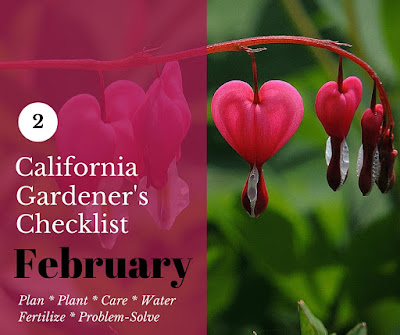This month can be such a mix of winter weather and false spring, it can make a gardener crazy. Just when a few days of spring-like blue skies and warm temperatures get our hearts beating faster, rainstorms can come crashing back in on us. But let's be thankful for every drop of rain we're getting this year--it's been a long time coming! And let's not let the rains keep us from our gardens! Here's what to focus on this month:
Plan
- Make a list of winter chores that you've yet to accomplish and make a plan of action for getting them done. Prioritize the tasks that must be done when plants are dormant: bare-root planting, transplanting, pruning or spraying.
- Order summer-blooming bulbs from catalogs.
- Make note of areas in the garden that are lacking winter color and consider filling in with winter-blooming natives like ceanothus and manzanita.
Plant
- Sow wildflower seeds.
- Plant asparagus, strawberries, and (if they're still dormant) bare-root fruit trees and kiwi vines.
- Sow seeds for a final round of cool-season annuals or get started on warm-season crops.
- Plant bare-root roses.
- Plant azaleas, rhododendrons, and camellias.
- Plant vines to fill in bare spots on fences, arbors and pergolas.
Care
- Deadhead cool-season annuals to prolong bloom.
- Divide herbaceous perennials.
- Clean up fallen camellia blossoms to avoid spread of fungal spores that cause petal blight.
- Cut back woody shrubs like artemisia, fuchsia, salvia, and butterfly bush to about 1 foot above the ground.
- If you've had serious pest or disease problems on deciduous trees, this it the time to apply a dormant spray, before the tree leafs out again.
- Finish all winter pruning.
Water
- Now that El Nino rains have come to the rescue, watch for signs of over-watering such as wilting or foliage turning a lighter shade of green.
Fertilize
- Stop fertilizing spring-blooming bulbs once they've begun to blossom.
- Apply a side-dressing of compost to roses after they've been pruned.
- Begin fertilizing deciduous fruit trees as soon as they begin to leaf out again.
- In coastal regions, begin fertilizing citrus and avocado trees.
Problem-Solve
- De-thatch established lawns that may have built up a thick layer of debris on the surface of the soil.
- Inspect citrus trees for mottled yellow splotches on the leaves--they could be a sign of infection of Huanglongbing disease (also called citrus greening disease). If you suspect an infection, report it at www.saveourcitrus.org or call the California Dept. of Food and Agriculture to have someone come and inspect your tree.
Photo: Walter A. Aue


It's February's despite everything it feeling really icy outside! Yet, indications of the new season are finally beginning to appear with knobs skewering through the ground carrying with them the energy and learning that winter won't keep going forever.
ReplyDelete